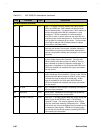
2-46 Service Guide
Table 2-10 C&T 65550 Pin Descriptions (continued)
Pin# Pin Name Type Description
PCI Bus Interface (continued)
31 PAR I/O Parity. This signal is used to maintain even parity across
AD0-31 and C/BE0-3#. PAR is stable and valid one clock
after the address phase. For data phases, PAR is stable and
valid one clock after either IRDY# is asserted on a write
transaction or TRDY# is asserted on a read transaction.
Once PAR is valid, it remains valid until one clock after the
completion of the current data phase (i.e., PAR has the same
timing as AD0-31 but delayed by one clock). The bus master
drives PAR for address and write data phases; the target
drives PAR for read data phases.
22 FRAME# In Cycle Frame. Driven by the current master to indicate the
beginning and duration of an access. Assertion indicates a
bus transaction is beginning (while asserted, data transfers
continue); de-assertion indicates the transaction is in the final
data phase.
23 IRDY# In Initiator Ready. Indicates the bus master's ability to complete
the current data phase of the transaction. During a write,
IRDY# indicates valid data is present on AD0-31; during a
read it indicates the master is prepared to accept data. A
data phase is completed on any clock when both IRDY# and
TRDY# are sampled then asserted (wait cycles are inserted
until this occurs).
24 TRDY# S/TS Target Ready. Indicates the target's ability to complete the
current data phase of the transaction. During a read, TRDY#
indicates that valid data is present on AD0-31; during a write
it indicates the target is prepared to accept data. A data
phase is completed on any clock when both IRDY# and
TRDY# are sampled then asserted (wait cycles are inserted
until this occurs).
27 STOP# S/TS Stop. Indicates the current target is requesting the master to
stop the current transaction
25 DEVSEL# S/TS Device Select. Indicates the current target has decoded its
address as the target of the current access
29 PERR# (VCLKOUT) S/TS Parity Error. This signal reports data parity errors (except the
Special Cycles where SERR# is used). The PERR# is
Sustained Tri-state. The receiving agent will drive PERR#
active two clocks after detecting a data parity error. PERR#
will be driven high for one clock before being tri-stated as with
all sustained tri-state signals. PERR# will not report status
until the chip has claimed the access by asserting DEVSEL#
and completing the data phase.


















